All, it has been a busy wildflower season! So many places to go and flowers to see. Here are some observations of flowers around Jackson Hole during these last couple of weeks. While fading at lower elevations, many of the same species are blooming, often with different companions, at higher altitudes and in different habitats. Others are more specialized to their particular niche.
Sageflats: Dry well drained soils and lots of sun!
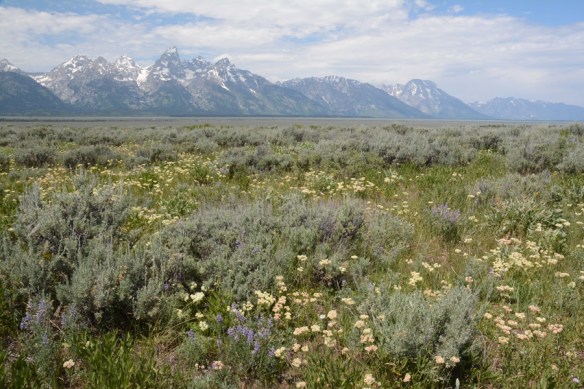 A drive along Antelope Flats Road or inner Park Road rewards one with clouds of Sulphur Wild Buckwheat – Eriogonum umbellatum.
A drive along Antelope Flats Road or inner Park Road rewards one with clouds of Sulphur Wild Buckwheat – Eriogonum umbellatum. 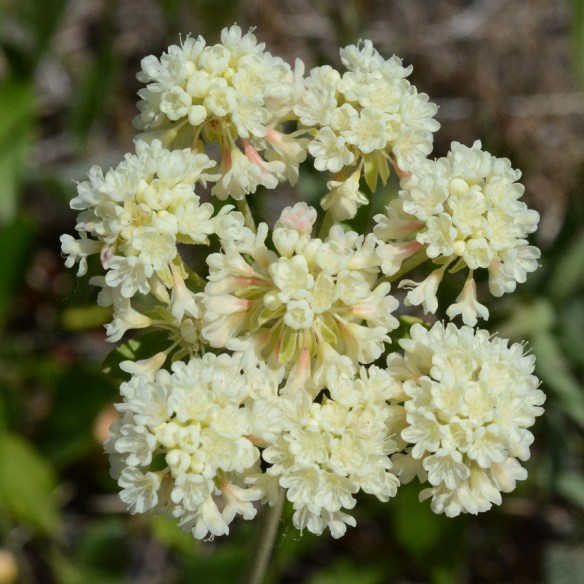 Flowers go from white to cream to pink as they age. The tiny, dried, winged fruits will be relished by rodents and birds.
Flowers go from white to cream to pink as they age. The tiny, dried, winged fruits will be relished by rodents and birds.
Silky Lupine – Lupinus sericeus – has been blooming for a week or two. Note the many hairs that cover the leaves and even back of the flowers. The hairs help prevent water loss. Bacteria are thriving in root nodules, providing the plants with usable nitrogen while the lofty lupine gives shelter and carbohydrates to the simple, tiny, yet crucial organisms.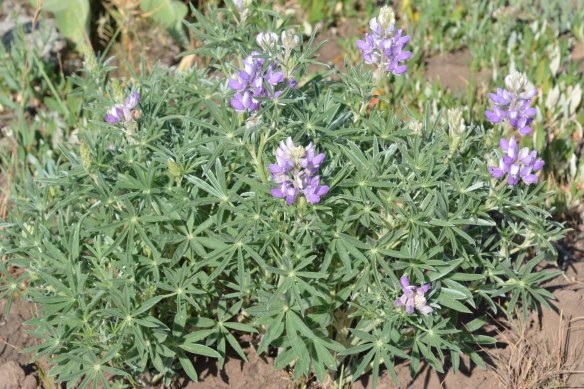 In some areas such as near Oxbow Bend or up Old Pass Road, Scarlet Gilia — Ipomopsis aggregata — appears particularly abundant this year. In other areas, it stands more or less among sagebrush.
In some areas such as near Oxbow Bend or up Old Pass Road, Scarlet Gilia — Ipomopsis aggregata — appears particularly abundant this year. In other areas, it stands more or less among sagebrush. 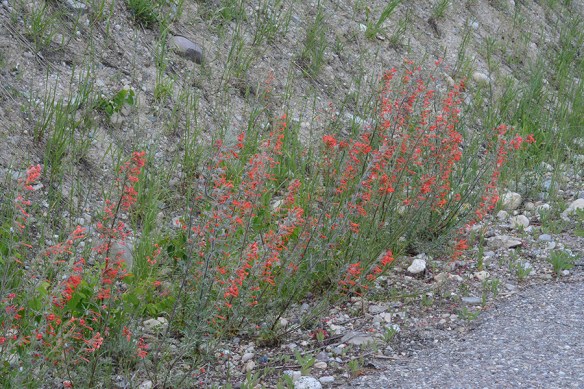 Look for hummingbirds or sphinx moths visiting the red tubular flowers. The long tubes are specialized to pollinators that can hover while drawing up the nectar deep inside the flower. Flowers have no fragrance—most birds don’t smell but they do see red.
Look for hummingbirds or sphinx moths visiting the red tubular flowers. The long tubes are specialized to pollinators that can hover while drawing up the nectar deep inside the flower. Flowers have no fragrance—most birds don’t smell but they do see red. 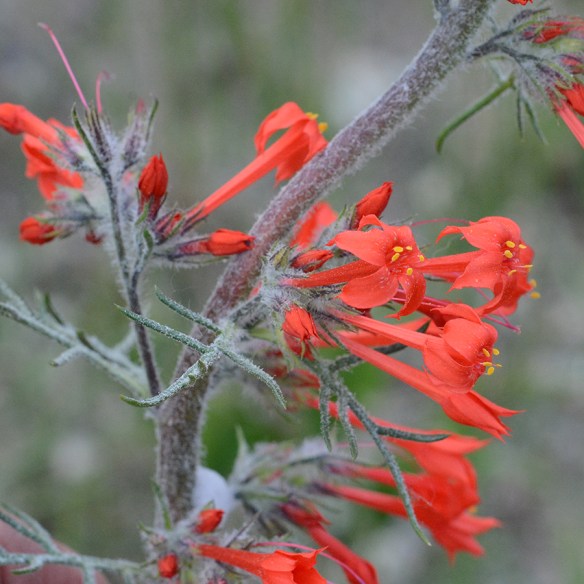 These tubular “regular” (petals are all the same shape) red flowers in the phlox family are not to be confused with a more complex “irregular” flowers of the Wyoming Paintbrush — Castilleja liniariifolia, our state flower. Formerly placed in the Snapdragon Family, now Paintbrushes are in the Broomrape Family because they are hemiparasites on other plants, such as sage and lupines. These plants derive sustenance, even chemical defenses, by attaching their weird roots to the roots of their hosts.
These tubular “regular” (petals are all the same shape) red flowers in the phlox family are not to be confused with a more complex “irregular” flowers of the Wyoming Paintbrush — Castilleja liniariifolia, our state flower. Formerly placed in the Snapdragon Family, now Paintbrushes are in the Broomrape Family because they are hemiparasites on other plants, such as sage and lupines. These plants derive sustenance, even chemical defenses, by attaching their weird roots to the roots of their hosts. 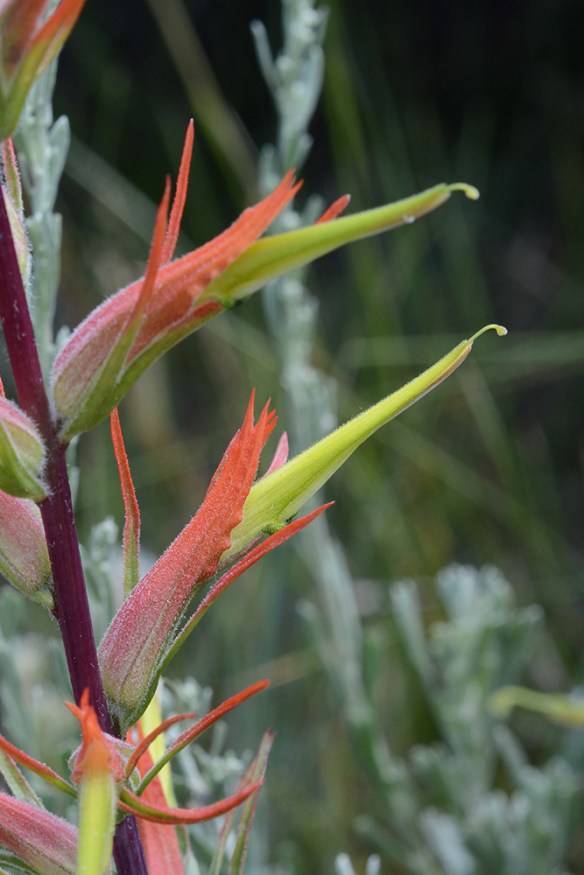 The green Wyoming Paintbrush flowers lean out beyond the colorful red sepals. Bracts just below add more color. The leaves are also lean with narrow lobes.
The green Wyoming Paintbrush flowers lean out beyond the colorful red sepals. Bracts just below add more color. The leaves are also lean with narrow lobes.
Hawksbeards – mostly Tapertip – Crepis acuminata – are abundant. Look for the many (up to 100!) yellow flower heads, each with about 5-10 ray flowers, and 5-8 smooth “involucral bracts” below. 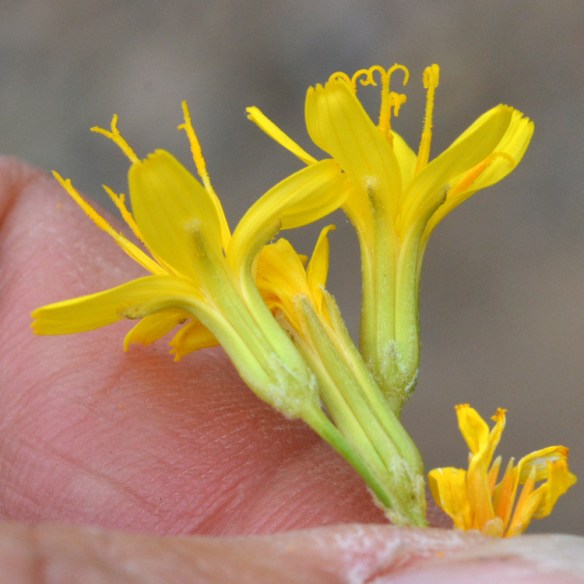 Leaves have several deep, sharply toothed lobes and are a bit fuzzy or “tomentose”.
Leaves have several deep, sharply toothed lobes and are a bit fuzzy or “tomentose”. 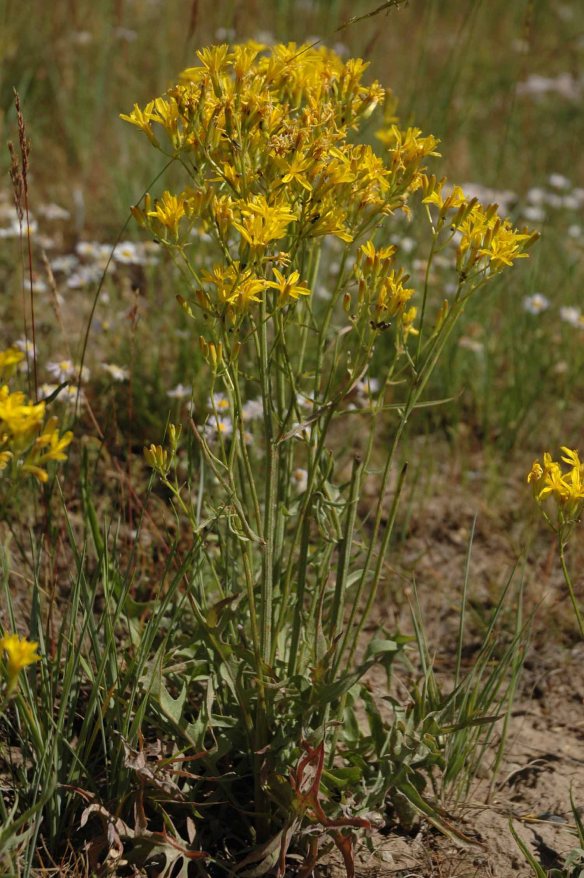 Modoc Hawksbeard – C. modocensis – has fewer flower heads (up to 40/plant) but each has more than 10-60 ray flowers and the bracts are stippled with black stiff hairs. Leaves and stem are very hairy. See if you can find these two species and discern the differences. There are other look-alike species as well.
Modoc Hawksbeard – C. modocensis – has fewer flower heads (up to 40/plant) but each has more than 10-60 ray flowers and the bracts are stippled with black stiff hairs. Leaves and stem are very hairy. See if you can find these two species and discern the differences. There are other look-alike species as well.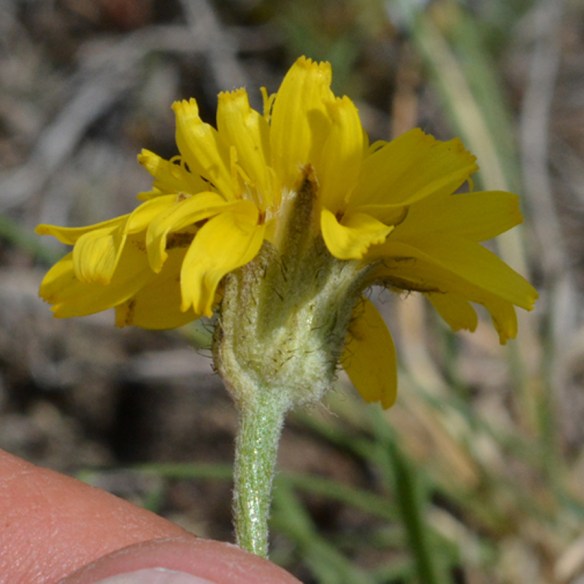
Another yellow composite with variations – Groundsels – rise about 12-18″ tall. The bracts are all one size, smooth, often black-tipped, and contain yellow “ray” and “disk” flowers. This one is Rocky Mountain Groundsel –– Packera. streptanthifolia. The leaves of three look-alike species are used for ID—leaves are variable in size and shape as they alternate up the stem.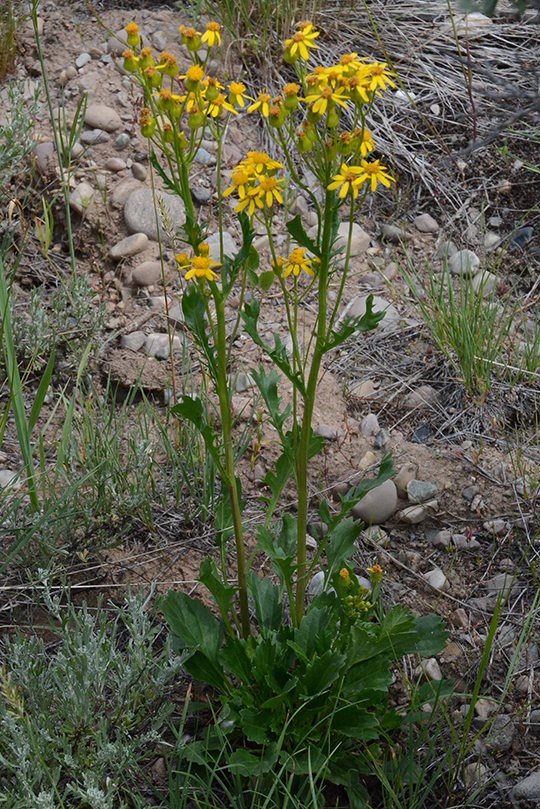
Lance-leaved Stonecrops or Sedum – Sedum lanceolatum – prefers well-drained soils to rocks. The pudgy leaves, which store water, alternate up the sprawling 4-6” stems. 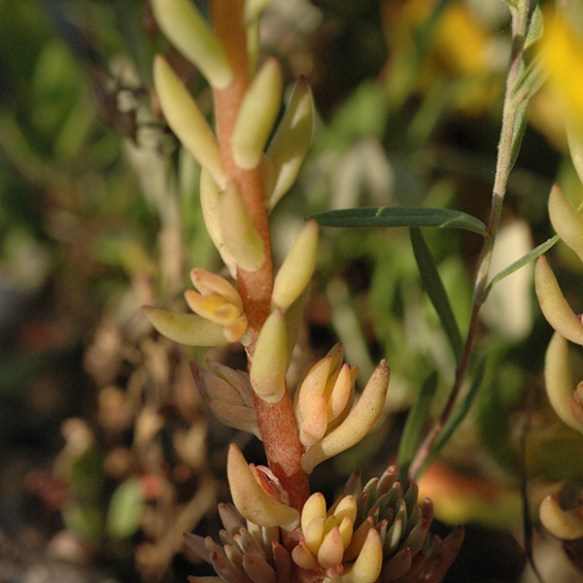
Flowers are bright yellow. 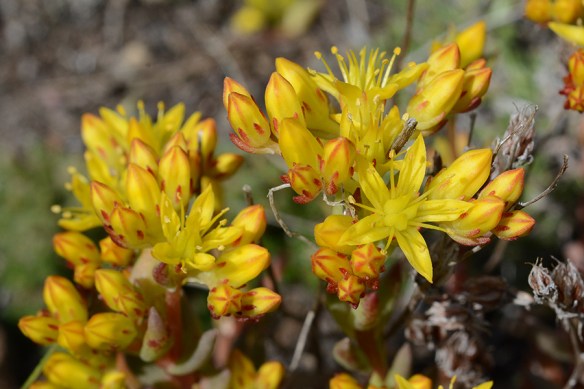 Members of the Stonecrop Family have a different type of metabolism – CAM – in order to do well in hot dry locations. They also are a host plant for the Rocky Mountain Parnassian butterfly Parnassius smintheus. (see: https://en.wikipedia.org/wiki/Parnassius_smintheus
Members of the Stonecrop Family have a different type of metabolism – CAM – in order to do well in hot dry locations. They also are a host plant for the Rocky Mountain Parnassian butterfly Parnassius smintheus. (see: https://en.wikipedia.org/wiki/Parnassius_smintheus
Yellow Indian Paintbrush – Castilleja flava – was still blooming strong in the dry sage and grasslands along Gros Ventre Road near the Red and Gray Hills. 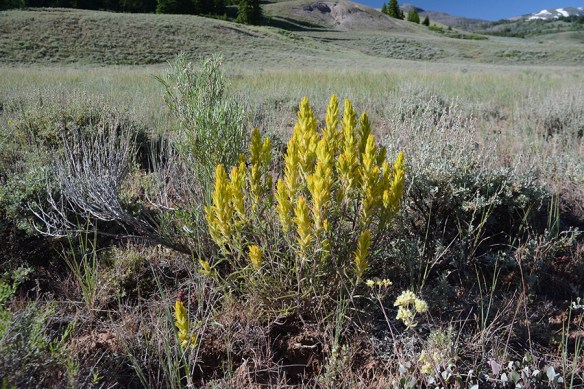 Note the arrangement of its flowers:
Note the arrangement of its flowers: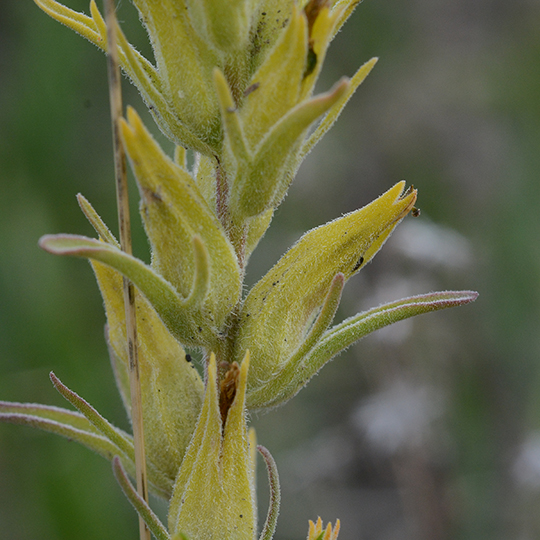
Also abundant in spots were bright magenta Northern Sweetvetch — Hedysarum boreale — clearly a member of the pea family. 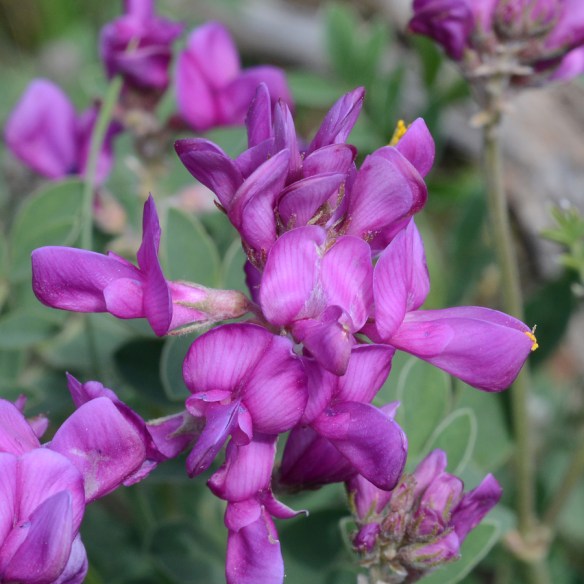
Ballhead Sandwort – Eremogone congesta – has a cluster of white flowers on the top of very thin stems. Leaves are opposite and needle like. This is a common, if overlooked, wild relative to our store-bought pink carnations.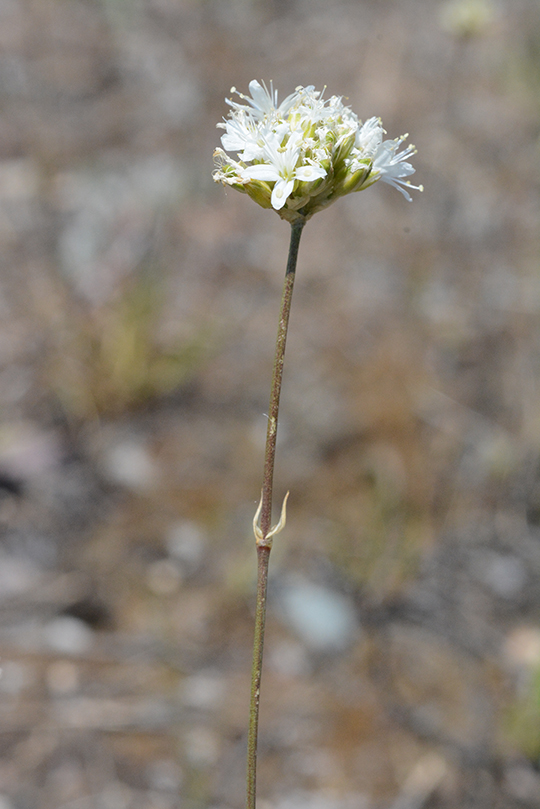
Various – and I mean various – fleabane daisies – Erigeron spp.—are common. They are hard to untangle botanically to this eye, in part because the roots are key to ID (and I don’t like to pull them up!), and then one examines hairs. Just knowing it is a native daisy is good enough for me. And I don’t think the insects bother with the difference either.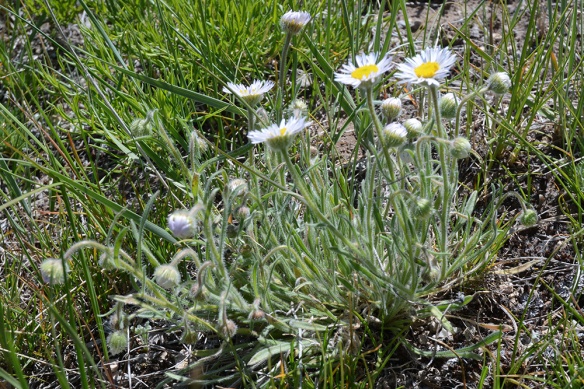
Mountain Meadows – cooler and moisterMeadows around String Lake and up the trail to Ski Lake feature lush arrangements of taller “forbs” or perennial flowers: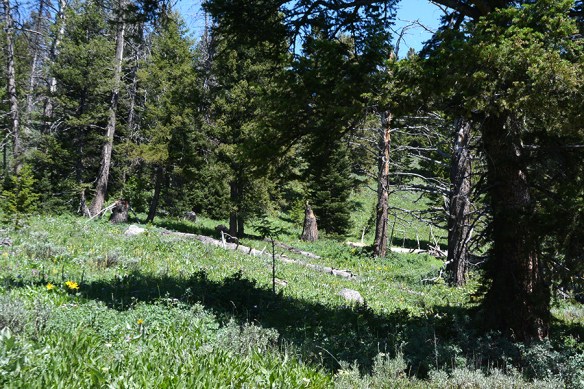 Sticky Geraniums – Geranium viscosissimum — are abundant. Here is a swallow-tail butterfly sucking up nectar. Anyone know which species?
Sticky Geraniums – Geranium viscosissimum — are abundant. Here is a swallow-tail butterfly sucking up nectar. Anyone know which species?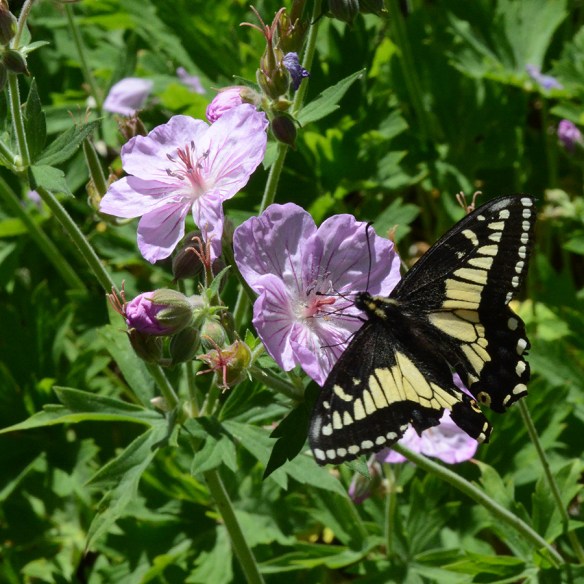 Scarlet Paintbrush – Castilleja miniata – is emerging.
Scarlet Paintbrush – Castilleja miniata – is emerging. 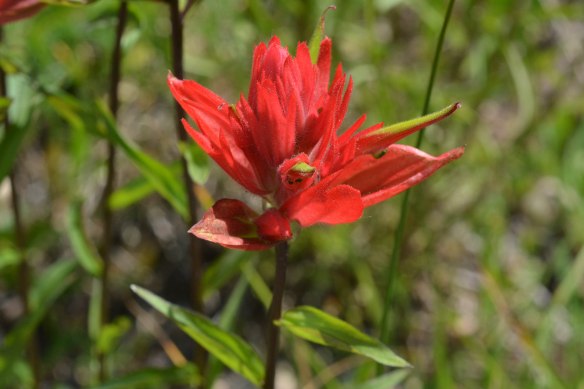 Note these flowers don’t lean out the same way the Wyoming Paintbrush does (compare with above photos) and the leaves are wider. Colors of paintbrushes can be variable but the flower details are relatively consistent…if they don’t hybridize with a nearby population of a similar species. Paintbrushes can be very confusing to ID!
Note these flowers don’t lean out the same way the Wyoming Paintbrush does (compare with above photos) and the leaves are wider. Colors of paintbrushes can be variable but the flower details are relatively consistent…if they don’t hybridize with a nearby population of a similar species. Paintbrushes can be very confusing to ID!
Silvery Lupine – Lupinus argenteus – is the common lupine of moist meadows and dappled light of aspen groves and evergreen forests. The back of the “banner” petal is hairless, unlike Silky lupine which is silky-hairy on the back. Hairs help reduce water loss, which is more of a concern in open drier sites. 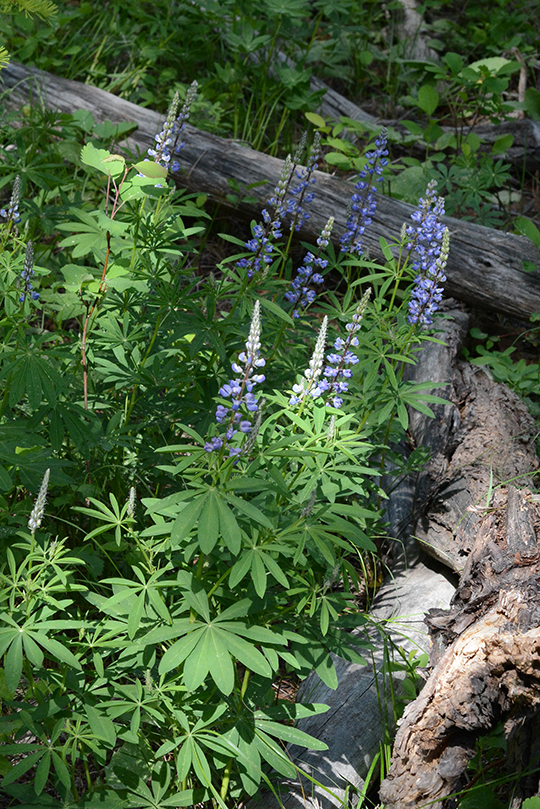
Tall Cinquefoil – Potentilla arguta – hold their flowers in tight erect fists. The yellow-to-white flowers are held up on glandular stalks 2 or more feet high. 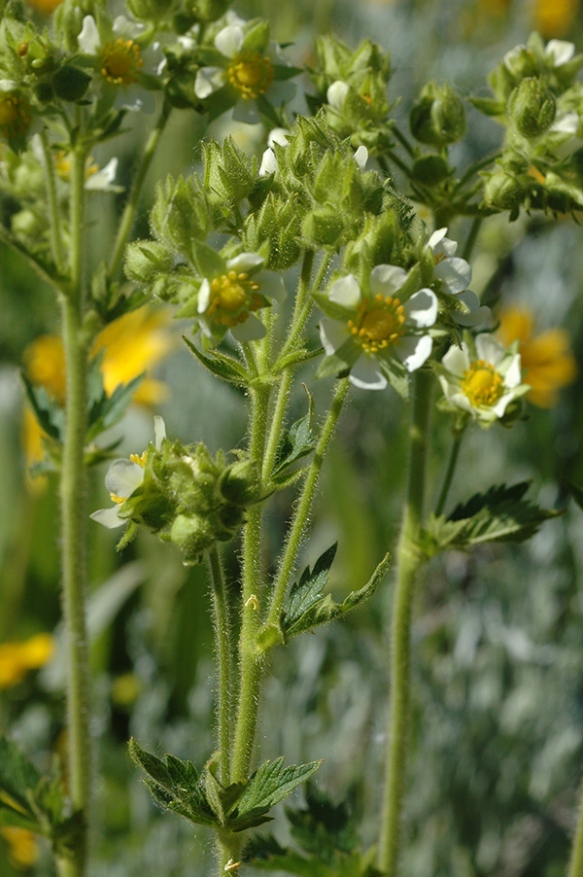
These are often confused with the more broadly spreading flower clusters of Gland or Sticky Cinquefoil — P. glandulosa . Both are common (and sticky with glandular hairs). 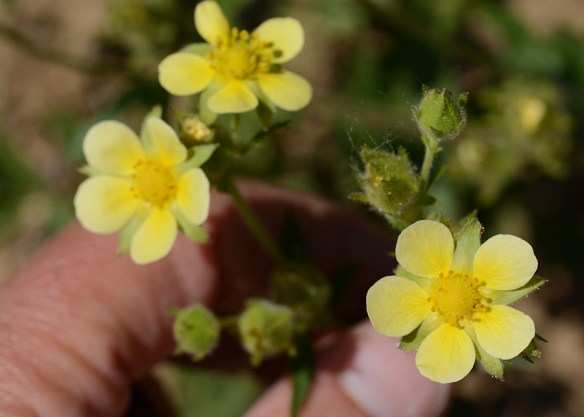 These open, accessible flowers are important for a variety of pollinators. Scientists have found plants contain a chemical that prevents tooth decay.
These open, accessible flowers are important for a variety of pollinators. Scientists have found plants contain a chemical that prevents tooth decay.
Several blue penstemons – Penstemon spp. — stand up through the vegetation or loom over a trail. ID distinctions include the color, hairiness, length, and angle of the anthers. 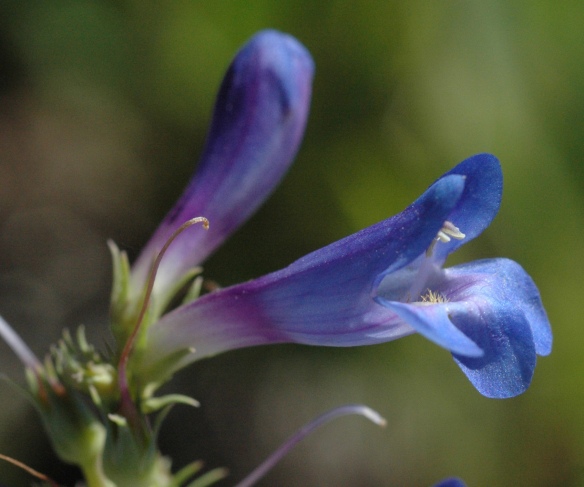 Botanists and gardeners thrive on these minute differences. Flower size affects bee pollinators which land on lower lip—they may or may not fit properly to reach the reward of nectar deep inside the flower while effectively carrying pollen to the next flower.
Botanists and gardeners thrive on these minute differences. Flower size affects bee pollinators which land on lower lip—they may or may not fit properly to reach the reward of nectar deep inside the flower while effectively carrying pollen to the next flower.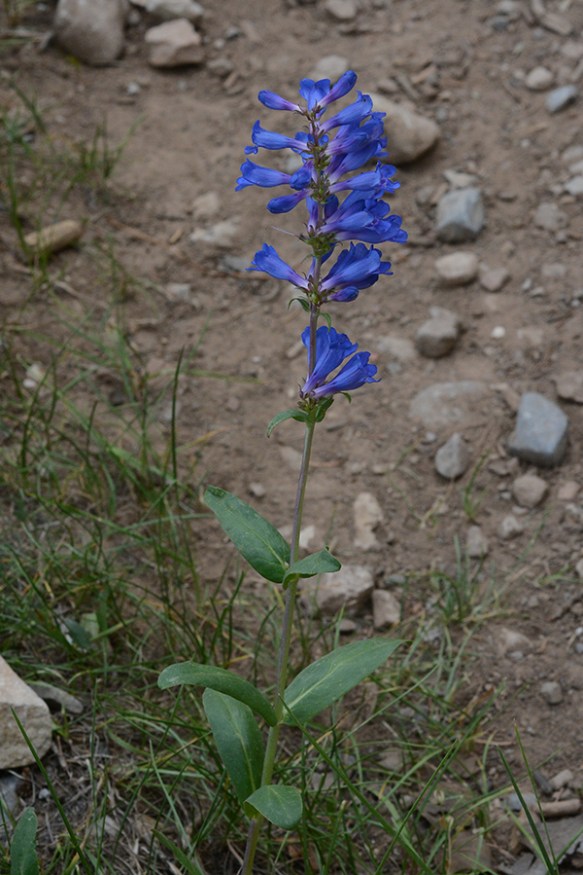 This species found along the Ski Lake Trail keyed out to Wasatch Beardstongue — P. cyananthus.
This species found along the Ski Lake Trail keyed out to Wasatch Beardstongue — P. cyananthus.
Flowers of our perennial Stickseed – Hackelia micrantha – mirror the summer blue sky above. Later tiny fruits will stick to socks and fur. 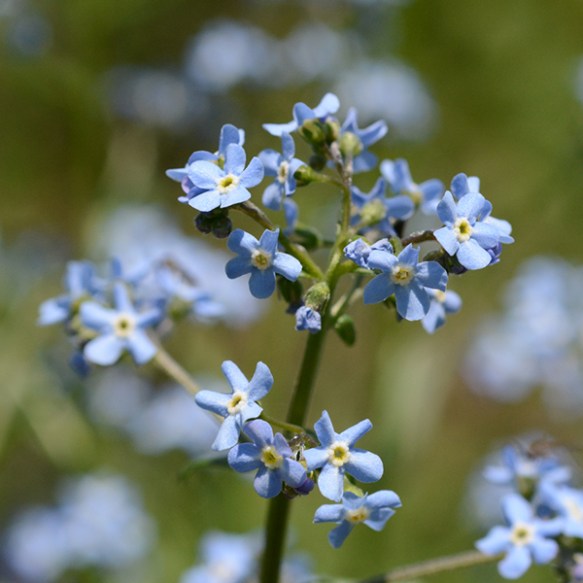
While phlox has mostly faded, its relative Nuttall’s Gilia — Leptosiphon nuttalli – (no good common name) is beginning to bloom. The deeply dissected leaves form frilly whorls up the slightly woody stems that form a 12″ tall mound. 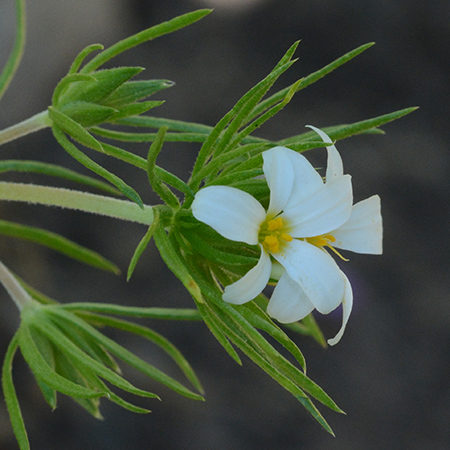 Flowers are extremely fragrant. Bend over for a whiff. It is also related to Scarlet Gilia.
Flowers are extremely fragrant. Bend over for a whiff. It is also related to Scarlet Gilia.
Western Sweetroot – Osmorhiza occidentalis – is common in meadows to open forest. 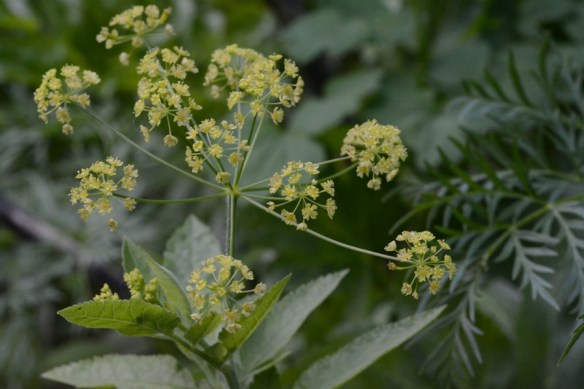 The tiny yellow-green flowers arranged in umbels will hold up schizocarps (split fruits) that taste like licorice. It is related to cumin, coriander, dill, anise, and many other tangy herbs in the Parsley family.
The tiny yellow-green flowers arranged in umbels will hold up schizocarps (split fruits) that taste like licorice. It is related to cumin, coriander, dill, anise, and many other tangy herbs in the Parsley family.
Louseworts are going and coming. Fern-leaf Lousewort – Pedicularis bracteosa – is fading fast at lower elevations, but beginning to bloom over 8,500’. 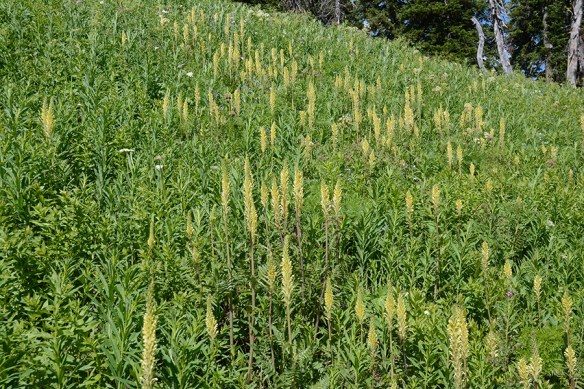 In lodgepole pine forests, Parrot’s Beaks — Pedicularis racemosa – are unfurling their flowers to attract specific pollinators. Usually a smart bee, channeled by nectar guides and the unique shape of the flower, lands on the lower petals, wriggles around, and vibrates its wings. Pollen grains bounce out of the beak-like tube of the upper petal and attach to the bee’s hairy back. Even with its long-comb-like legs, the bee can’t glean all the pollen: some remains out of reach in the crevice between the bee’s head and thorax. Visiting the next ready flower, the bee’s positioning will cause the stigma to curve around and tap the pollen out of the crack for successful fertilization! (see lower right flower)
In lodgepole pine forests, Parrot’s Beaks — Pedicularis racemosa – are unfurling their flowers to attract specific pollinators. Usually a smart bee, channeled by nectar guides and the unique shape of the flower, lands on the lower petals, wriggles around, and vibrates its wings. Pollen grains bounce out of the beak-like tube of the upper petal and attach to the bee’s hairy back. Even with its long-comb-like legs, the bee can’t glean all the pollen: some remains out of reach in the crevice between the bee’s head and thorax. Visiting the next ready flower, the bee’s positioning will cause the stigma to curve around and tap the pollen out of the crack for successful fertilization! (see lower right flower)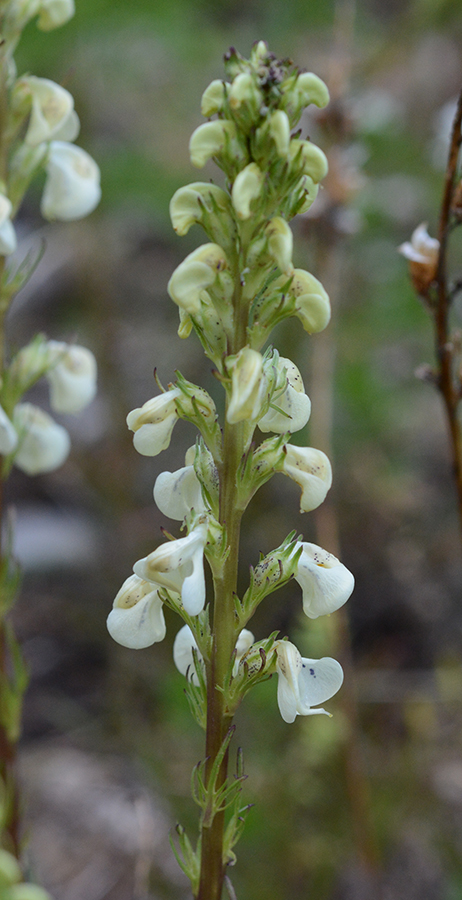
High Elevations – late blooming!
Elevations above about 8,500’ are noticeably delayed in flower this year. South of Teton Pass and above Ski and Goodwin Lakes, one finds only early spring flowers. Carpets of Spring Beauties — Claytonia lanceolata — are sprouting where snow drifts are finally melting. 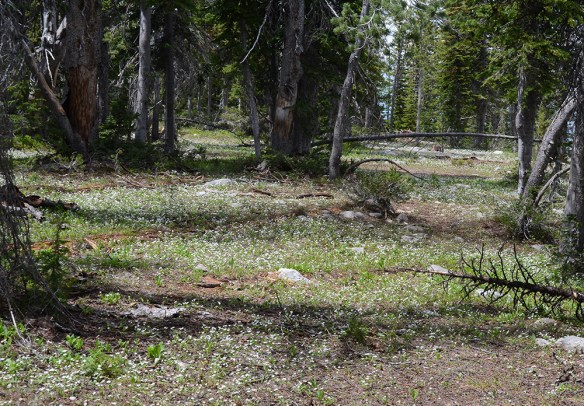 Species particularly adapted to very short growing seasons are also blooming where snow has just melted. Patches of Rocky Mountain Snow Buttercups – Ranunculus adoneus – are frequent. Note their fine leaves.
Species particularly adapted to very short growing seasons are also blooming where snow has just melted. Patches of Rocky Mountain Snow Buttercups – Ranunculus adoneus – are frequent. Note their fine leaves.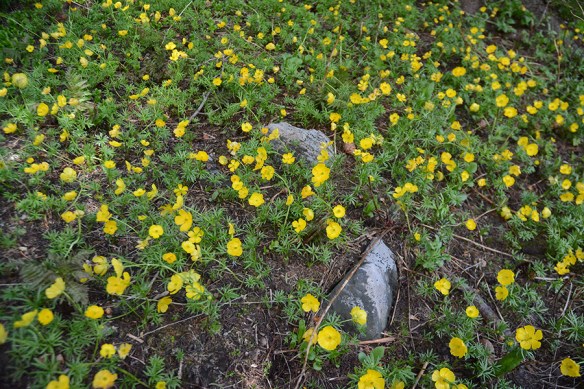
There are many, many more flowers to see. This is just a preview and hopefully incentive for you to explore, identify, and understand the remarkable plant world around us.
Frances Clark, Wilson, WY
July 16, 2019
We appreciate comments, corrections, and additions. Please let us know what you think about this posting. We will do our best to incorporate your thougts.
